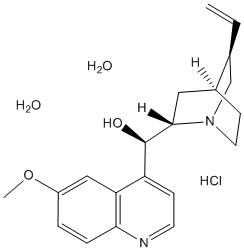All AbMole products are for research use only, cannot be used for human consumption.

Quinine hydrochloride dihydrate is a natural white crystalline alkaloid having antipyretic (fever-reducing), antimalarial, analgesic (painkilling), anti-inflammatory properties and a bitter taste.It is a stereoisomer of quinidine which, unlike quinine, is an anti-arrhythmic. Quinine contains two major fused-ring systems: the aromatic quinoline and the bicyclic quinuclidine. It is very sensitive to ultraviolet light (UV) and will fluoresce in direct sunlight, due to its highly conjugated resonance structure.
| Molecular Weight | 396.91 |
| Formula | C20H24N2O2.HCl.2H2O |
| CAS Number | 6119-47-7 |
| Solubility (25°C) | DMSO 70 mg/mL |
| Storage |
Powder -20°C 3 years ; 4°C 2 years In solvent -80°C 6 months ; -20°C 1 month |
[1] Sandra Simes, et al. Palatability of pediatric formulations: do rats predict aversiveness?
[5] Zelmra Bezkov, et al. Alkalimetric titrations of salts of organic bases in the Pharmacopoeia
| Related Potassium Channel Products |
|---|
| VU0810464
VU0810464 is a potent and selective non-ureaG protein-gated inwardly-rectifying potassium channels (GIRK, Kir3) activator. VU0810464 displays nanomolar potency for neuronal (EC50=165 nM) and GIRK1/4 (EC50=720 nM) channels with improved brain penetration. |
| QO 58
QO 58 is a potent modulator of K(v)7 channels. |
| NS3623
NS3623 is an activator of human ether-a-go-go-related gene (hERG1/KV11.1) potassium channels. |
| ML67-33
ML67-33 is a selective activator of temperature- and mechano-sensitive K2P channels. |
| A-935142
A-935142 is a human ether-a-go-go-related gene (hERG, Kv 11.1) channel activator. |
All AbMole products are for research use only, cannot be used for human consumption or veterinary use. We do not provide products or services to individuals. Please comply with the intended use and do not use AbMole products for any other purpose.


Products are for research use only. Not for human use. We do not sell to patients.
© Copyright 2010-2024 AbMole BioScience. All Rights Reserved.
